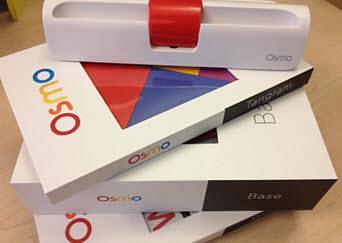Osmo – Not just a kids game
19 November 2014 - Amy McInnes

As part of World Usability Days theme on Engagement, I chose to showcase a game that I felt not only had a great User Interface (UI), but that captured this years theme in numerous ways. May I present Osmo(this will open in a new window).

Osmo promotes social intelligence and creative thinking by bringing online interaction back into the real world through three simple, yet highly engaging, games (you’ll most likely remember from your childhood).
How it works
Osmo works by recognising objects in the real world by using the iPad’s front-facing camera with a mirror. This mirror enables the camera to look down on the area in front of the iPad, Osmo’s play space, and reflect its content back onto the iPad.
This raw digital image starts as an array of numbers which is then transformed into a recognisable object. It’s the speed, accuracy and ability to work in a variety of environments that show Osmo’s design quality.
The game engine integrates the objects recognised by computer vision; taking the physical objects and digitising them into the game in real time.
The games
The three games allow the user to interact with just about any physical object — pen, paper, blocks, your hand, even toys your child already owns:
- “Newton” requires players to guide an on-screen falling ball into a target by placing objects or drawing lines on a piece of paper in front of the iPad.

- “Tangram” requires the player to use coloured shapes placed in front of the iPad to match onscreen images. The game provides excellent feedback, as shapes are placed in the correct positions a musical note is played, and there’s a little jingle once the form is complete.

- “Words” is like “hangman” and “scrabble” combined. Using the on-screen image as the clue, players guess the word by placing lettered tiles in front of the iPad, bringing social interaction and friendly competition into play (this was highly competitive during our WUD with certain managing directors). These pictures and words can even be personalised.
The benefits
Although we all love our tablet devices, they are reported to be having effects on child development(this will open in a new window); social skills, motor skills, and cognitive skills are all showing impacted learning.
Osmo is tackling such areas:
- Social skills / Emotional learning – Osmo has removed the single game play associated with iPads and promotes group engagement and shared game play.
- Motor skills / Spatial intelligence – The real world engagement with objects uses motor skills and develops spatial recognition underutilised by many iPad games.
- Cognitive development – By thinking outside the box, children are encouraged to use any object to help play the game.
Osmo has also been seen to also help those with cognitive impairment (read the touching story on the Osmo blog(this will open in a new window)). These are only a few of the advantages.
WUD outcomes
Apart from obviously appealing to children, it was clear that all those who came along to WUD clearly enjoyed the games too. Competitive spirts where high with many interested in finding out more and potentially purchasing one for their children/self (shame we weren’t on commission J).
After playing the games, it was interesting was to see how else people thought Osmo could be developed.
- Accessibility (e.g. used with those who have communication problems i.e. have suffered a stroke or autism difficulties connecting with other people and working in a team).
- Medical Education (e.g. Words focused on Skelton parts or dissection)
- Mechanics Education
- Language Education (e.g. help teach foreign languages with Word game)
- Currency Education
- Maths Education (e.g. change the Word game to a maths game)
- Interior design (e.g. help you structure and choose the furniture in a chosen space)
- Catering (design your own pizza/meal/desert through drop and drag)
- Team building (e.g. ice breaker)
There were many great ideas, perhaps not all in the capabilities of Osmo, but certainly something to think about. If you have any other ideas, do let us know in the comments section below.
You might also be interested in...
Bridging Business Analysis and User Experience: Achieve Outstanding Digital Results
24 November 2025Discover how aligning Business Analysis and User Experience transforms digital projects - boosting efficiency, user satisfaction, and ROI for organisations seeking exceptional results in today’s competitive market.
Read the article: Bridging Business Analysis and User Experience: Achieve Outstanding Digital ResultsUsing the Kano Model to Drive Product Success
14 October 2025The Kano Model helps product teams understand what drives customer satisfaction. Features are grouped as Mandatory, Satisfier, Delighter, Indifferent, or Rejectors - each affecting the user experience in different ways. By balancing these feature types, teams can make smarter decisions, avoid clutter, and build products that truly delight users.
Read the article: Using the Kano Model to Drive Product SuccessConsumer Duty Compliance: Measuring Outcomes That Matter
4 March 2025Explore how financial services can move beyond traditional satisfaction metrics to master outcome measurement for Consumer Duty compliance. Learn about Key Experience Indicators (KEIs) and strategic approaches with User Vision's expertise.
Read the article: Consumer Duty Compliance: Measuring Outcomes That Matter